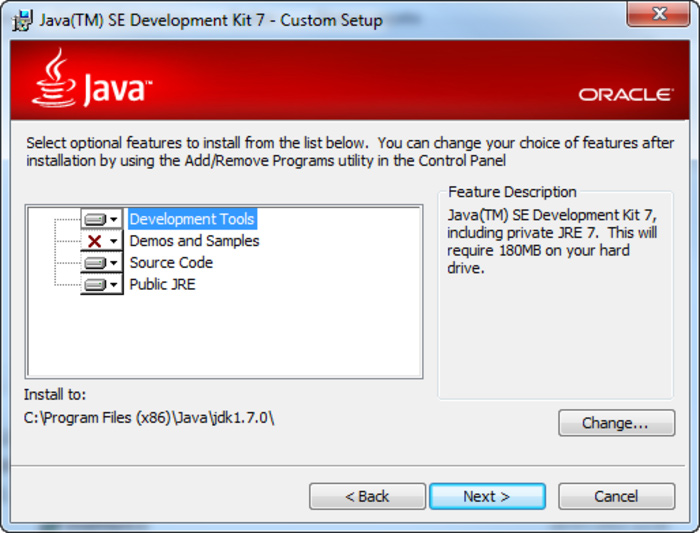2 days ago Java Platform, Standard Edition Installation Guide Contents Previous Next 1 JDK 8 and JRE 8 Installation Start Here This page gives access to instructions for installing the JDK and JRE on Oracle Solaris, Windows, Linux, and OS X computers. 0, it was released on Jun 5, 2018. 30 Download For Mac Hp 6960 Printer Software Download For Mac Download. The Java Development Kit (JDK). Java Hello Hello, world from Mac! How to Install JDK on Ubuntu. There are several JDK implementations available for Linux, such as Oracle JDK, OpenJDK, Sun JDK, IBM JDK and GNU Java Compiler. We shall choose the Oracle JDK 8. Ubuntu chooses OpenJDK as its default JDK, which is not 100% compatible with Oracle JDK. It looks like support for the Java Oracle JDK version 8 will be deprecated after January 2019 Java SE Overview. Java WebStart fails on Mac OS Mountain Lion. Mac OS X Port Project. The goal of this Project is to produce a high-quality, open source version of JDK 7 for the Mac. The final release has the following goals: Pass all appropriate certification tests for Java SE 7; Include a complete, native Cocoa-based UI Toolkit; Provide excellent performance; This Project is sponsored by the Porters.

Take a look at how you can quickly get started with OpenJDK with this tutorial that gives you commands for installing version 7-11 through a Mac Terminal.
Join the DZone community and get the full member experience.
Join For FreeIn this article, I will be using Homebrewto install OpenJDK versions on the Mac.
We use brew install to install JDK versions 8,9,10, andbrew cask installfor version 11 and above.
All the brew commands are executed in the Terminal window on the Mac.
Install OpenJDK Versions 8, 9, and 10
brew tap AdoptOpenJDK/openjdk
brew search /adoptopenjdk/
The Formulae section contains the identifiers for the various JDK versions.
To install a specific JDK version: brew install <identifier>
e.g. to install OpenJDK 8: brew install adoptopenjdk/openjdk/adoptopenjdk-openjdk8
JAVA_HOME should be set by the developer to /usr/local/Cellar/adoptopenjdk-openjdk8/jdk8u172-b11.
Install OpenJDK Version 11
brew cask install adoptopenjdk
JAVA_HOME should be set by the developer to /Library/Java/JavaVirtualMachines/adoptopenjdk-11.jdk.
Opinions expressed by DZone contributors are their own.
This page describes how to install and uninstall JDK 8 for OS X computers.
This page has these topics:
See 'JDK 8 and JRE 8 Installation Start Here' for general information about installing JDK 8 and JRE 8.
See 'OS X Platform Install FAQ' for general information about installing JDK 8 on OS X.
System Requirements



Observe the following requirements:
Any Intel-based computer running OS X 10.8 (Mountain Lion) or later.
Administrator privileges.
Note that installing the JDK on OS X is performed on a system wide basis, for all users, and administrator privileges are required. You cannot install Java for a single user.
Installing the JDK also installs the JRE. The one exception is that the system will not replace the current JRE with a lower version. To install a lower version of the JRE, first uninstall the current version as described in 'Uninstalling the JRE'.
JDK Installation Instructions
When you install the Java Development Kit (JDK), the associated Java Runtime Environment (JRE) is installed at the same time. The JavaFX SDK and Runtime are also installed and integrated into the standard JDK directory structure.
Depending on your processor, the downloaded file has one of the following names:
jdk-8uversion-macosx-amd64.dmgjdk-8uversion-macosx-x64.dmg
Download Java 8 Jdk For Mac
Where version is 6 or later.
Download the file.
Before the file can be downloaded, you must accept the license agreement.
From either the Downloads window of the browser, or from the file browser, double click the
.dmgfile to launch it.A Finder window appears containing an icon of an open box and the name of the
.pkgfile.Double click the package icon to launch the Install app.
The Install app displays the Introduction window.
Note:
In some cases, a Destination Select window appears. This is a bug, as there is only one option available. If you see this window, select Install for all users of this computer to enable the Continue button.Click Continue.
The Installation Type window appears.
Click Install.
A window appears that says 'Installer is trying to install new software. Type your password to allow this.'
Enter the Administrator login and password and click Install Software.
The software is installed and a confirmation window appears.
Refer to
http://www.oracle.com/technetwork/java/javase/downloads/jdk-for-mac-readme-1564562.htmlfor more information about the installation.After the software is installed, delete the
.dmgfile if you want to save disk space.
Determining the Default Version of the JDK
Jdk 1.8 Download For Mac
If you have not yet installed Apple's Java OS X 2012-006 update, then you are still using a version of Apple Java 6 that includes the plug-in and the Java Preferences app. See 'Note for Users of OS X that Include Apple Java 6 Plug-in'.
There can be multiple JDKs installed on a system, as many as you wish.
Download Java Jdk 8 For Mac
When launching a Java application through the command line, the system uses the default JDK. It is possible for the version of the JRE to be different than the version of the JDK.

You can determine which version of the JDK is the default by typing java -version in a Terminal window. If the installed version is 8u6, you will see a string that includes the text 1.8.0_06. For example:
To run a different version of Java, either specify the full path, or use the java_home tool:
Java Jdk 8 Download
For more information, see the java_home(1) man page.
Uninstalling the JDK
To uninstall the JDK, you must have Administrator privileges and execute the remove command either as root or by using the sudo(8) tool.
For example, to uninstall 8u6:
Do not attempt to uninstall Java by removing the Java tools from /usr/bin. This directory is part of the system software and any changes will be reset by Apple the next time you perform an update of the OS.
